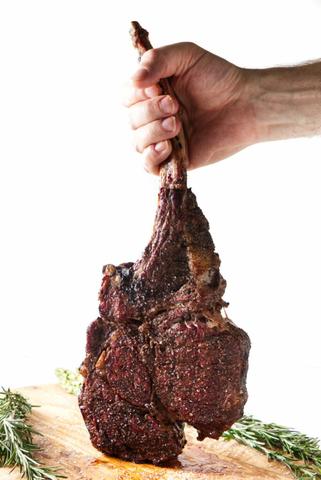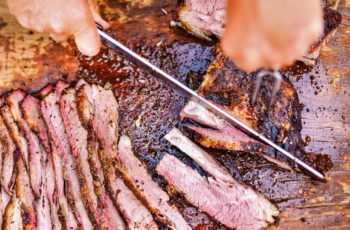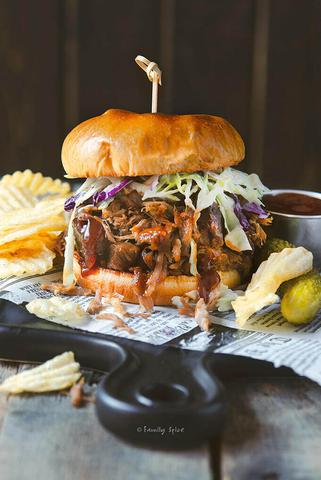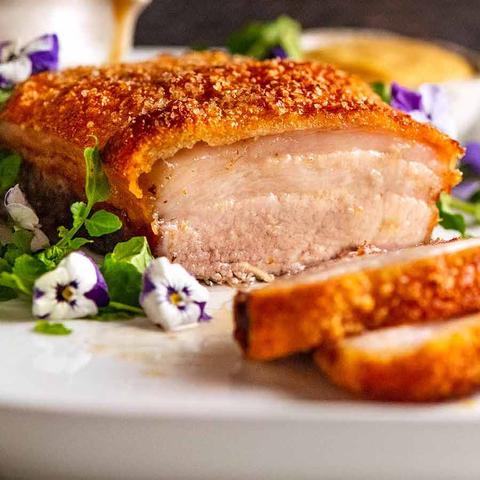
“Indulge in the exquisite flavors of Roast Pork Belly: a succulent and crispy dish that tantalizes your taste buds. Discover the perfect harmony of tender meat, melt-in-your-mouth fat, and a delightful crackling skin. Elevate your culinary experience with this mouthwatering delight that promises to satisfy even the most discerning palates.”
Roast Pork Belly in the Oven

Roast pork belly in the oven is a delicious main dish that is both easy to make and affordable. With a crispy skin and tender meat, oven-roasted pork belly makes a great main dish or even an appetizer. It can be used in various ways, such as in tacos, bao buns, or as tasty little morsels to snack on.
To cook pork belly in the oven, it needs to be cooked low and slow so that the meat becomes tender and the fat breaks down properly. The most challenging part of cooking pork belly is achieving a crispy skin. While it may take a long time to cook pork belly in the oven, it is one of the best methods for even cooking and getting crispy skin without having to switch to another cooking method.
To cook pork belly with crispy skin, you need to score the skin and rub it with salt or a dry rub containing plenty of salt. It’s best to refrigerate the pork belly overnight uncovered so that the skin can dry out. Then, preheat the oven and roast the pork belly covered in foil for several hours until tender. Afterward, remove it from the foil and crisp up the skin at a higher temperature.
Ingredients You Need
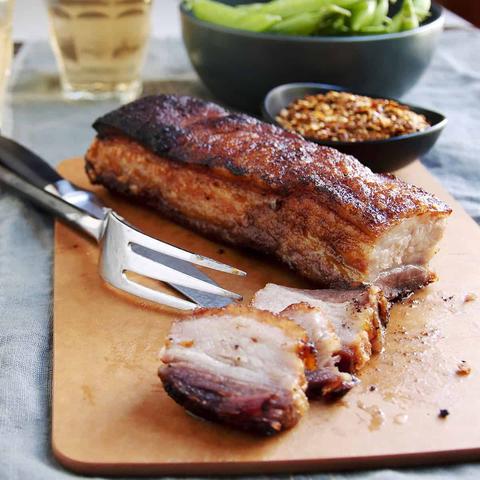
To make oven roasted pork belly, you will need the following ingredients:
- Pork belly
- Olive oil
- Salt and pepper
- Dry rub (optional)
Thermapen ONE (read our review)
The Thermapen ONE is a must-have tool for cooking pork belly in the oven. With its fast and accurate temperature readings, you can ensure that your pork belly is cooked to perfection. The Thermapen ONE has a super quick response time of one second or less, and an accuracy of ± 0.5°, so you’ll always know the exact temperature of your meat.
One of the best features of the Thermapen ONE is its auto-rotate display and motion-sensing technology. This means that no matter which angle you hold it at, the display will always be easy to read. Plus, it automatically turns on when you pick it up and shuts off when you set it down, saving battery life.
Speaking of battery life, the Thermapen ONE has an insanely long battery life of up to 2000 hours. This means that you won’t have to worry about constantly replacing batteries or running out of power in the middle of cooking.
The Thermapen ONE also comes with a 5-year warranty, giving you peace of mind knowing that it’s built to last. Whether you’re a professional chef or a home cook, the Thermapen ONE is a valuable tool for cooking pork belly and many other dishes.
What Is Pork Belly?
Pork belly is a cut of meat that comes from the belly of a pig. It is known for its rich and flavorful taste, as well as its balance of meat and fat. Pork belly is often used in various dishes, such as pork belly bao buns, pork belly tacos, sandwiches, and more. In order to make pork belly tender and delicious, it needs to be cooked low and slow to render the fat and break down the connective tissues. While some may think that bacon and pork belly are the same thing, they actually differ in their texture and usage in cooking. Bacon is made from cured, smoked, and thinly sliced pork belly or other cuts of meat. On the other hand, side pork is a term that can be used interchangeably with pork belly in some cases. However, side pork is usually less processed and does not undergo the same curing or smoking process as bacon. Overall, pork belly offers a unique flavor profile and versatility in cooking.
Bacon vs Pork Belly
Bacon and pork belly are often mistaken for being the same thing, but there are some key differences between the two. Bacon is made from pork belly that has been cured, smoked, and sliced thinly. It has a distinct salty and smoky flavor. On the other hand, pork belly refers to the unprocessed cut of meat that comes from the belly of a pig. It is known for its balance of meat and fat, which makes it tender and flavorful when cooked properly.
In terms of texture and usage in cooking, bacon and pork belly also differ. Bacon is typically crispy when cooked, while pork belly can be tender and juicy. Bacon is commonly used as a breakfast food or added to dishes for flavoring, while pork belly can be used as a main dish or incorporated into various recipes such as tacos, bao buns, or sandwiches.
It’s important to note that side pork is another term that may be used interchangeably with pork belly in some regions. Side pork refers to a more raw and unprocessed form of pork belly without additional flavorings or treatments. However, in most cases, side pork and pork belly describe very similar products.
Overall, bacon and pork belly offer their own unique flavors and textures, making them versatile ingredients in various culinary creations.
Side Pork vs. Pork Belly
Side pork and pork belly are two terms that are often used interchangeably, but there are some differences between the two. Side pork is typically the same cut as pork belly, but in a more raw and unprocessed form. It does not undergo the curing or smoking process that turns pork belly into bacon. Side pork is similar to fresh pork belly without any additional flavorings or treatments. However, in some regions, side pork may refer to a slightly different cut of meat that includes more of the side of the pig. Overall, side pork and pork belly are very similar products with slight variations in preparation and region.
How to Make Roast Pork Belly
Making roast pork belly is a delicious and satisfying process. Here are the steps to follow:
1. Preheat your oven to 285°F (140°C) and prepare the pork belly by scoring the skin with a sharp knife. Rub salt or a dry rub into the skin, making sure to get it into the slits.
2. Place the pork belly on a sheet of foil and fold it up to create a loose enclosure. This will help retain moisture during cooking.
3. Roast the pork belly in the oven for 2 1/2 hours at this low temperature. After an hour, tighten up the foil around the pork to ensure even cooking.
4. Once cooked, remove the pork belly from the foil and turn up the oven temperature to 475°F (245°C). If you want crispy skin, place the pork belly on a wire rack over a baking tray and cook for an additional 20 minutes. Keep an eye on it to prevent burning.
5. Let the pork belly rest for 10 minutes before slicing it into your desired thickness.
You can serve roast pork belly as a main dish or use it in various recipes like tacos or sandwiches. It pairs well with side dishes like crispy roast potatoes or salads.
Leaving the Skin On?
Leaving the Skin On?
If you want to keep the skin on and go for the nice crunchy crispy skin, there are a few steps you need to follow. First, score the skin with a sharp knife, making sure not to cut into the meat. Then, rub salt or a dry rub with plenty of salt into the scored skin and season the other side of the meat as well. It’s best to put the pork belly in the refrigerator, uncovered, overnight so that the skin can dry out properly.
When it’s time to cook, preheat the oven to 285°F and rub about 1 teaspoon of olive oil all over the pork belly. Cut two sheets of tin foil large enough to encapsulate the pork belly and make a little boat out of them. Place the pork in the foil boat, skin side up, and fold up the foil to enclose it. The foil should be close around the sides of the pork but not tight against it. Secure it on top so that no steam escapes.
Place the foil packet on a baking tray in the oven and roast for 2 1/2 hours at 285°F. After about an hour of cooking, tighten up the foil around the pork as it will have shrunk a bit. Once cooked for 2 1/2 hours, remove from oven and increase temperature to 475°F.
Remove pork from foil and place it on a wire rack over the baking tray. If you left on the skin, this is where you’ll be crisping it up. If not, roast for an additional 5-10 minutes at high heat for a nice crispiness on outside.
Let cool for 10 minutes before slicing if skin is left on; otherwise let rest before slicing.
To slice with skin left on: turn pork belly upside down before slicing as this makes cutting through crispy skin easier.
Serve as desired – thicker slices for main dish, thinner slices for appetizers. You can also use thinner slices to make pork belly sandwiches, sliders, and tacos.
Leftover pork belly can be stored in the refrigerator for up to 5 days. When reheating, you can do so in the oven, air fryer, or on a pan depending on the size of the chunk. For slices, heating in a pan on the stove top is best. For larger chunks, place them in an air fryer at 350°F for 5 minutes.
Pork belly can be served as a main dish with or without sauce. However, if desired you can serve it with ponzu sauce, Vermouth Jus or sweet soy sauce drizzled on top.
Overall, cooking pork belly with the skin on requires some extra steps and attention to detail but results in a deliciously crispy skin that complements the tender meat perfectly.
Roasting the Pork Belly
To roast the pork belly, start by preheating the oven to 285°F. Rub the pork belly with olive oil and season it with salt and pepper or a dry rub. If you want crispy skin, score the skin and rub it with salt or a dry rub that has plenty of salt in it. Let the pork belly sit uncovered in the refrigerator overnight to allow the skin to dry out.
Cut two sheets of tin foil large enough to enclose the pork belly. Make a little boat out of the foil and place the pork belly in it, skin side up. Fold up the foil to fully enclose the pork, leaving some space around the sides for steam. Place the foil packet on a baking tray and roast for 2 1/2 hours.
After an hour of cooking, tighten up the foil around the pork as it will have shrunk a bit. After 2 1/2 hours, remove the tray from the oven and increase the oven temperature to 475°F. Remove the pork from the foil packet and place it on a wire rack over the baking tray.
If you left on the skin, roast at high heat for about 20 minutes until crispy. Keep an eye on it to avoid burning. If you removed the skin, roast for an additional 5-10 minutes at high heat to give it a nice crispiness. Let it rest for 10 minutes before slicing.
Turn Up the Heat
Pork belly is a delicious and versatile cut of meat that can be cooked in a variety of ways. One popular method is to roast it in the oven, which results in tender meat and crispy skin. Cooking pork belly in the oven requires low and slow cooking to ensure the meat becomes tender and the fat properly renders down. The skin can be a challenge to perfect, but with the right technique, you can achieve a crispy and flavorful result.
To cook pork belly in the oven, start by scoring the skin and rubbing it with salt or a dry rub. This helps dry out the skin and promote crispiness. Letting the pork belly sit uncovered in the refrigerator overnight further enhances its ability to develop a crunchy skin. When ready to cook, preheat the oven to 285°F and wrap the pork belly in foil, making sure not to tightly seal it. Roast for 2 1/2 hours, then increase the oven temperature to 475°F for crisping up the skin. Once cooked, let it rest before slicing.
Pork belly can be served as a main dish or used in various recipes such as tacos, bao buns, or sandwiches. Leftovers can be stored in the refrigerator for up to 5 days and reheated using methods like air frying or pan heating. While pork belly is flavorful on its own, you can also serve it with sauces like ponzu sauce or sweet soy sauce for added taste.
Slice the Pork Belly
To slice the pork belly, allow it to cool for about 10 minutes after removing it from the oven. If you left the skin on, turn the pork belly upside down to make it easier to cut through the crispy skin. Slice the pork belly to your desired thickness, whether you’re serving it as a main dish or as an appetizer. Thicker slices work well for a main dish, while thinner slices are great for appetizers like pork belly sandwiches or tacos. Serve and enjoy!
Storing & Reheating Pork Belly
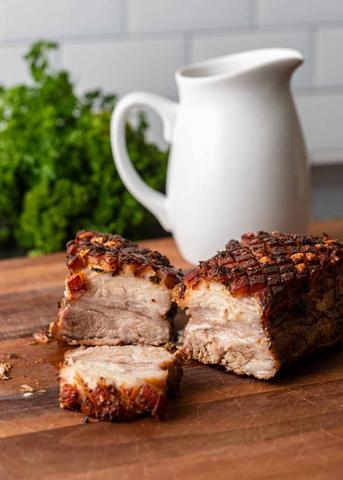
Storing & Reheating Pork Belly:
Pork belly can be easily stored and reheated if you have leftovers. After allowing the pork to cool completely, place it in a dish or container and cover it before storing it in the refrigerator. It will stay fresh for up to 5 days.
When you’re ready to reheat the pork belly, there are a few methods you can choose from depending on the size of the piece. If you have slices, the best method is to heat them in a pan on the stove top. For larger chunks, using an air fryer set at 350 degrees F for 5 minutes works well.
Whether you serve pork belly as a main dish or as part of an appetizer, it’s delicious on its own without any sauce. However, if desired, you can pair it with ponzu sauce, Vermouth Jus, or sweet soy sauce drizzled on top. Some popular side dishes to serve with pork belly include crispy roast potatoes or a wedge salad.
How to Serve Pork Belly

Pork belly can be served in a variety of ways, depending on your preference and the occasion. Here are a few ideas:
1. As a main dish: Slice the cooked pork belly into thick pieces and serve it as the star of the meal. Pair it with roasted vegetables, mashed potatoes, or a fresh salad for a delicious and satisfying dinner.
2. In sandwiches or sliders: Thinly slice the pork belly and layer it in between slices of bread or buns for a flavorful sandwich. Add some lettuce, tomato, and your favorite condiments for extra taste.
3. In tacos or bao buns: Shred the cooked pork belly and fill soft tortillas or steamed buns with it. Top with fresh vegetables, salsa, and a squeeze of lime for a tasty and unique twist on traditional tacos or bao buns.
4. As an appetizer: Cut the cooked pork belly into bite-sized pieces and serve them on toothpicks as an appetizer at parties or gatherings. You can also serve them with dipping sauces like ponzu sauce or sweet soy sauce for added flavor.
5. In other dishes: Get creative with how you use pork belly by incorporating it into other recipes. Use it as a topping for pizzas, add it to pasta dishes, or mix it into fried rice for added texture and flavor.
No matter how you choose to serve it, pork belly is sure to impress with its tender meat and crispy skin. Enjoy!
Frequently Asked Questions
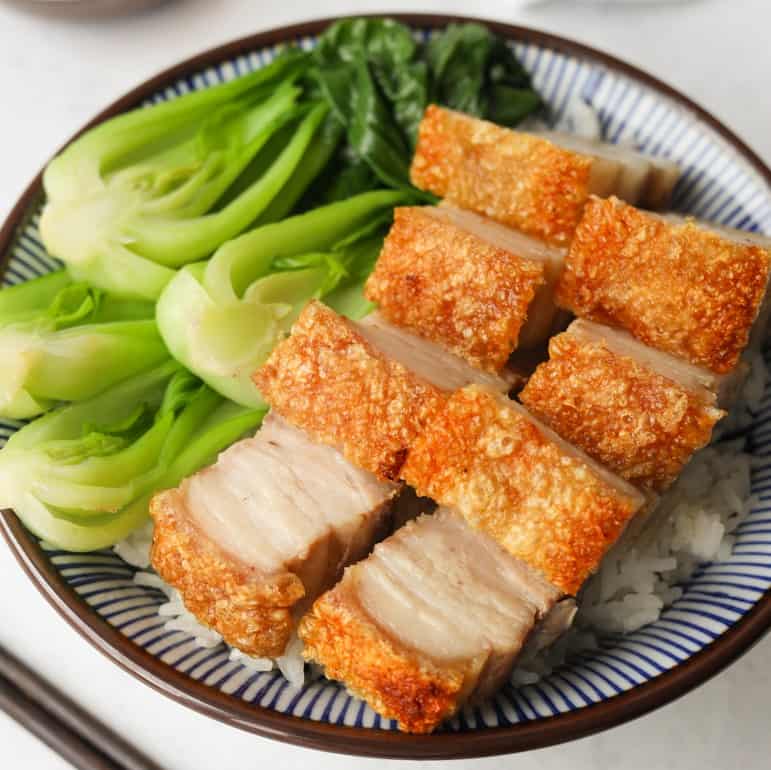
1. What is pork belly?
Pork belly is a cut of meat that comes from the belly of a pig. It is known for its balance of meat and fat, which makes it rich and flavorful.
2. How do you cook pork belly in the oven?
To cook pork belly in the oven, you need to cook it low and slow at around 285°F for 2 1/2 hours. After that, you can increase the temperature to 475°F to crisp up the skin, if desired.
3. Can I remove the skin from pork belly?
Yes, if you don’t want to keep the skin on, you can easily remove it with a sharp knife before seasoning and cooking the meat.
4. How do I get crispy skin on pork belly?
To achieve crispy skin on pork belly, you need to score the skin and rub it with salt or a dry rub that has plenty of salt in it. The salt helps dry out the skin so it can become crispy during cooking.
5. How do I store and reheat leftover pork belly?
You can store leftover pork belly in a covered dish or container in the refrigerator for up to 5 days. To reheat, you can use methods such as oven, air fryer, or stovetop pan depending on the size and thickness of the meat.
What temperature should pork belly be cooked at?
When cooking pork belly in the oven, the recommended cooking temperature range is around 300°F to 375°F (150°C to 190°C). This temperature allows the meat to cook slowly and evenly, resulting in tender and juicy pork belly. If you’re braising the pork belly, the recommended oven temperature is usually around 275°F to 325°F (135°C to 165°C). For grilling or barbecuing, a higher cooking temperature of around 350°F to 400°F (175°C to 200°C) can be used. The cooking time for pork belly will vary depending on factors such as size, thickness, and desired result, but generally takes about 2 to 3 hours when roasting in the oven.
How long does it take to cook a pork belly?
Roasting pork belly in the oven typically takes about 2 to 3 hours at a temperature of around 300°F to 375°F (150°C to 190°C). The cooking time can vary depending on factors such as the size and thickness of the pork belly, the cooking method, and whether you prefer a tender or crispy result. If you’re braising pork belly, plan on cooking it for about 3 to 4 hours or more, depending on thickness and desired tenderness. Grilling or barbecuing pork belly will take around 1.5 to 2.5 hours, depending on how well you want the skin or fat to crisp up.
To ensure that your pork belly turns out crispy, there are a few factors to consider. Make sure the skin is dry before roasting, as any moisture can prevent proper crisping. Score the skin to help render out the fat underneath and promote crispiness. Cooking at a low temperature may result in less crispy skin, so consider increasing the temperature if needed. Avoid crowding the pork belly in the oven or trapping steam with baking sheets that have sides, as this can hinder crispiness. Finally, try not to poke or flip the pork belly too often during cooking, as this can disrupt the skin’s ability to crisp up.
To cook pork belly without it becoming tough, choose a cut with an even distribution of fat and connective tissues. Scoring the skin helps render out fat during cooking and promotes tenderness. Cook it low and slow to break down connective tissues and tenderize the meat. Alternatively, opt for braising methods that further tenderize the meat through slow simmering in liquid. After cooking, allow the pork belly to rest before slicing against the grain to break down muscle fibers.
Overall, cooking times and techniques may vary depending on personal preference and desired results. Experimentation with different temperatures and methods can help you achieve the perfect pork belly dish.
Why is my pork belly not crispy in the oven?
There are several factors that may contribute to your pork belly not turning out as crispy as you’d like when cooking it in the oven. One possible reason is if the skin is damp or moist before roasting, as this can prevent proper crisping. Another factor could be if the skin isn’t scored, which can result in the fat underneath not rendering out adequately, leading to less crispy skin. Additionally, if you’re roasting the pork belly at a low temperature, the skin may not have a chance to become crispy. It’s also important to avoid crowding the pork belly in the oven or placing it on a baking sheet with sides that trap steam, as this can hinder crispiness. Finally, try not to poke or flip the pork belly too often during cooking, as this can disrupt the skin’s ability to crisp up.
How do you cook pork belly so it’s not tough?
To cook pork belly so that it’s not tough, there are a few important steps to follow. First, choose a cut of pork belly with an even distribution of fat. This will help ensure that the meat stays moist and tender during cooking. Next, score the skin of the pork belly to allow the fat to render out properly. This will help prevent the skin from becoming rubbery and tough.
When cooking pork belly, it’s best to cook it low and slow. This means cooking it at a lower temperature for a longer period of time. This allows the connective tissues in the meat to break down, resulting in a more tender end result. You can roast pork belly in the oven at around 300°F to 375°F for about 2 to 3 hours.
Another option is to braise the pork belly. Braising involves cooking the meat slowly in liquid, which helps keep it moist and tender. To braise pork belly, you can cook it at around 275°F to 325°F for about 3 to 4 hours or more, depending on the thickness and desired tenderness.
After cooking, it’s important to let the pork belly rest before slicing into it. This allows the juices to redistribute throughout the meat, resulting in a more flavorful and tender final product.
By following these steps, you can ensure that your pork belly turns out juicy and tender, rather than tough and chewy.
In conclusion, roast pork belly is a delicious and flavorful dish that can be enjoyed by many. Its crispy skin, tender meat, and rich flavors make it a popular choice among food lovers. Whether served as a main course or used in various recipes, this dish never fails to satisfy taste buds. So, don’t miss out on the opportunity to indulge in this mouthwatering culinary delight!
Learn More About Grilling
If you want to learn more about grilling, check out these other helpful resources!


